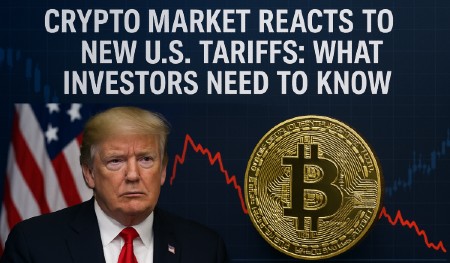Crypto Meets Geopolitics
The cryptocurrency market, long considered a decentralized hedge against traditional finance, is no longer immune to global economic policies. Recent sweeping U.S. tariffs introduced by President Donald Trump have sent shockwaves through financial markets—crypto included. In early April 2025, this policy shift triggered a sell-off across digital assets, causing Bitcoin and other major cryptocurrencies to fall sharply alongside related stocks.
The Tariff Announcement and Immediate Market Response
On April 3, 2025, President Trump proposed a 10% blanket tariff on global imports, targeting trade partners like China, Mexico, and the European Union. This unexpected move heightened investor anxiety, particularly over inflation and global economic instability.
Read announcement from White House related to tariffs.
As a result, Bitcoin dipped below $82,000—a significant psychological threshold—before modestly rebounding. Ethereum, XRP, and other top coins followed suit with losses ranging from 5% to 8% in a single day. The total crypto market cap fell by approximately 6%, landing around $2.6 trillion within 24 hours.
Crypto Stocks Also Take a Hit
Crypto-related equities mirrored the decline:
- Coinbase Global (COIN): Down nearly 7%
- MicroStrategy (Strategy): Fell over 7%
- Robinhood Markets: Dropped 9%
- Marathon Digital Holdings (MARA): Plunged more than 8%
The sell-off suggests a tightening correlation between digital assets and traditional equity markets—especially among firms with strong exposure to the crypto ecosystem.
Why Tariffs Affect Crypto
Although cryptocurrencies are decentralized and borderless, they don’t operate in a vacuum. Here’s why the new tariffs have rattled the market:
- Risk-Off Sentiment: Macroeconomic uncertainty often leads investors to pull back from volatile assets like crypto.
- Inflation Concerns: Higher import costs may trigger inflation, which central banks might counter with interest rate hikes—something the crypto market typically reacts poorly to.
- Institutional Pressure: With institutional investors holding significant crypto positions, the broader market is increasingly influenced by Wall Street sentiment.
Market Analysts Weigh In
Financial experts caution that while crypto might have once acted as a safe haven, it’s now more reactive to macroeconomic indicators. According to analysts at Investopedia and Barron’s, the alignment between crypto and traditional stocks is strengthening, especially in times of uncertainty.
At the same time, some believe this turbulence offers long-term buying opportunities. Bitcoin’s fall below $82,000 may prove temporary, with several bullish on-chain signals still intact.
What This Means for Crypto Investors
With geopolitical tensions and economic policies reshaping global markets, crypto investors should:
- Monitor economic indicators like inflation, trade balances, and central bank decisions.
- Diversify portfolios to reduce exposure to market-wide shocks.
- Stay informed about legislative and regulatory changes that could impact crypto taxation and trading.
While short-term volatility is likely, long-term fundamentals for cryptocurrencies—such as blockchain adoption, decentralized finance (DeFi), and tokenized assets—remain strong.

